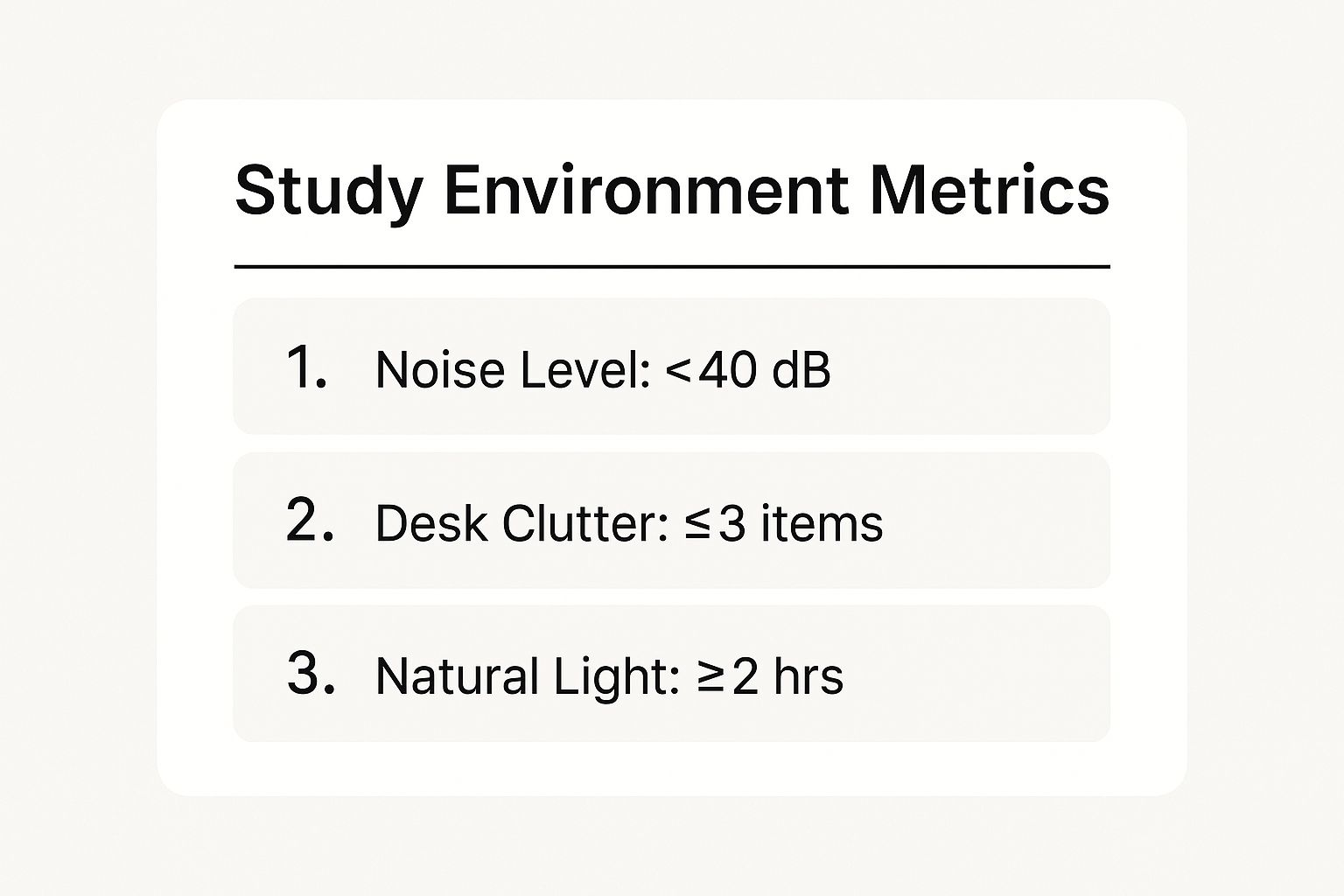Finding the motivation to study isn't about brute force. It starts with a much quieter, more honest question: why is it missing in the first place? It’s far less about forcing your child to sit down with a textbook and more about helping them reconnect with their purpose, breaking down overwhelming tasks into small, manageable wins, and creating an environment that actually supports them.
Acknowledging the real, often emotional, roots of their struggle is the first and most important step to helping them get that drive back.
Why Study Motivation Fades and How to Reignite It

It’s a feeling we all know. That textbook sits on the desk, but picking it up feels like trying to lift a boulder. Every ping from a phone feels like a welcome escape, and the urge to do anything else—tidy the room, stare out the window, reorganise the sock drawer—is immense.
If this sounds familiar, the first thing your child needs to hear is this: you are not lazy. You're human.
This lack of drive is almost never a character flaw. More often than not, it’s an emotional response to pressures bubbling under the surface. When your child loses the will to revise, it’s a clear signal that something deeper needs attention.
The Real Reasons Their Motivation Disappears
Think about the last time your child felt truly stuck. Were they staring at a page of complex equations, feeling their brain physically shut down? Maybe they just got a disappointing grade on an assignment they poured hours into, leaving them wondering, "What's even the point?"
These are the moments where motivation starts to crumble. The real culprits are often things like:
- Intense Pressure to Succeed: When the expectation to get top marks—from family, teachers, or even themselves—is relentless, studying stops feeling like learning and starts feeling like a high-stakes performance they can't afford to fail. The joy is replaced by fear.
- Fear of Not Being Good Enough: Let’s be honest, sometimes it feels safer for a child to just not try than to give it their all and still fall short. This fear can be paralysing, turning procrastination into a strange form of self-protection from the pain of potential failure.
- A Disconnect from the Subject: If they can’t see how a topic connects to their life or their future, it’s completely natural to feel disengaged. Why would anyone be inspired to learn something that feels pointless?
The core issue isn't a lack of discipline; it's often a lack of connection or an excess of fear. Realising this allows you to approach the problem with compassion for your child, not criticism.
Take, for example, a student who lives and breathes art but is stuck in a required maths module. The subject feels abstract, irrelevant, and utterly disconnected from their passion. Every homework problem becomes a battle. Their struggle isn't about being "bad at maths"; it's about the emotional toll of not seeing how it fits into their world.
Reigniting their motivation isn't about telling them to grit their teeth and force themselves to study. It’s about understanding these emotional triggers and tackling them head-on. It’s about being kind to them and helping them build their drive back up from a place of strength, not shame.
Connect Their Studies to What Truly Matters to Them

Let’s be honest, the promise of a good grade on its own is a pretty flimsy motivator. It might get a child through a single assignment, but it’s rarely enough to carry them through the exhaustion of late-night revision or the frustration of a concept that just won’t click.
Real, lasting motivation doesn't come from external rewards. It comes from connecting the daily grind to something that genuinely matters to them. This is about digging deeper to find their core ‘why’—the real, heartfelt reason they’re putting in all this effort.
Discovering Their Personal Driving Force
Your child's ‘why’ doesn’t need to be some grand, world-changing mission. It just needs to be theirs. It’s the emotional anchor that gives meaning to all the hard work.
Think about it in real terms:
- The aspiring nurse isn't just memorising anatomical terms; she’s picturing the moment she uses that knowledge to calmly reassure an anxious patient. Her motivation is rooted in a deep sense of compassion.
- The future engineer isn't just solving another physics problem; he’s imagining the sustainable water filtration system he wants to design for a community in need. His drive comes from a desire to make a tangible, positive impact.
- The dedicated teenager helping at home isn't just ticking off assignments for a business degree; they’re focused on the stability and opportunities a better career will give their family. Their motivation is pure love.
What picture comes to mind for your child? Is it the quiet satisfaction of finally mastering a skill they thought was impossible? Or maybe it’s the pride they’ll feel making their family proud? This internal vision is what will keep them going when the finish line feels miles away.
Crafting a Purpose Statement
Once you’ve helped them get a handle on their ‘why’, boil it down to a simple, powerful purpose statement. This isn’t a formal essay for a tutor; it’s a personal reminder for when their energy is flagging. Keep it short, sharp, and specific to them.
For example, a student passionate about the environment could write: “I am learning these complex ecological models so I can help protect our planet’s biodiversity for the next generation.” Suddenly, a tedious task is reframed as a meaningful step toward a deeply held value. If environmental issues resonate with them, exploring practical actions like reducing plastic waste and living more sustainably can make their connection to their studies even stronger.
A purpose statement transforms academic tasks from obligations into meaningful actions. It’s the reason they choose to open the book when they’d rather do anything else.
By taking this kind of ownership over their learning, your child develops crucial skills for success. Encourage them to pin their statement above their desk, set it as their phone’s wallpaper, or write it on the first page of their notebook. Let it be the first thing they see when they sit down to study. This simple act keeps their ultimate goal front and centre, giving them a steady source of motivation that comes from within.
Create a Study Space That Actually Boosts Focus

A study environment is more than just a desk and a chair. It’s a powerful tool that can either drain a child's energy or sharpen their concentration. Trying to learn in a cluttered, noisy, or distracting room is like trying to swim against a strong current—it makes the fight against procrastination ten times harder.
The goal isn’t just to be tidy. It’s to create a space that genuinely supports your child. A well-designed study area acts as a cue for their brain, signalling that it’s time to get down to work and making it far easier to slip into a productive mindset.
Design a Space That Works for Them
A great study space is deeply personal and should be built around what your child needs. There are no hard and fast rules, but a few key elements are known to significantly reduce the friction that stops them from getting started.
Think about making these practical adjustments:
- Optimise The Lighting: Bad lighting leads to eye strain and headaches, making them feel tired before they’ve even opened a book. Try to position their desk to catch natural light. For evenings, a good desk lamp with warm light makes a world of difference.
- Declutter Their Desk and Digital Life: A messy desk equals mental clutter. Keeping their physical space organised is vital; think about using effective organization tools like clear storage bins. The same goes for their digital world. Use apps to block distracting websites when it's time to focus.
- Control the Noise: Some children thrive on the low buzz of a coffee shop, while others need total silence. Don’t be afraid to experiment with noise-cancelling headphones, white noise apps, or instrumental music to figure out what helps them concentrate. We take a deeper dive into this in our guide on how to concentrate during your studies.
The UK's educational landscape is changing fast, proving just how important a personalised environment has become. With the educational technology sector growing by 72% since 2020, more students are finding that flexible, remote learning setups are a better fit for them. In fact, a recent survey found that 77% of UK learners believe remote education is as effective as traditional methods. This really highlights that motivation sparks when the learning environment adapts to the child, not the other way around.
Make Their Space Emotionally Supportive
Beyond the practical stuff, the emotional feel of their space is crucial. This is about transforming it from just a place of work into a personal sanctuary that reminds them of their 'why'.
A study space should be a visual representation of their goals. It’s not just about removing distractions; it's about adding inspiration.
Help your child surround themselves with things that connect them to their ambitions. For example, a student aiming for a career in veterinary science might keep a photo of their family pet on their desk. It’s a simple visual cue, but it can be a powerful, loving reminder of their passion when they’re struggling through a difficult chapter on cellular biology.
Another student, saving up for a trip to Japan, could put a postcard of Tokyo on their wall. Every time they look up from their notes, they see a tangible reminder of what all their hard work is building towards. These small, personal touches are what turn a sterile desk into a motivating command centre.
Practical Ways to Overcome Study Procrastination
Procrastination is one of the biggest walls we hit when trying to find the motivation to study. It’s crucial to realise, though, that this isn’t about laziness. Far more often, it’s an emotional response to feeling overwhelmed, anxious, or just plain bored by the task ahead.
The secret isn't to fight it with brute force. Instead, you need to gently coax the brain into action using compassionate, psychology-backed strategies. Forget staring at a mountain of revision and feeling defeated before even starting. The goal is to make that first step so ridiculously small it feels almost effortless. This simple shift helps build momentum without triggering the stress that fuels procrastination in the first place.
The Power of Tiny Habits and Timed Sessions
Two of the most effective methods for snapping the procrastination cycle are the ‘Two-Minute Rule’ and the ‘Pomodoro Technique’. They work because they dramatically lower the barrier to entry, turning intimidating tasks into something much more approachable.
- The Two-Minute Rule: This one is simple. Just commit to doing two minutes of a task. The goal isn't to finish anything, but just to start. For that history essay they’ve been dreading, this might mean opening a Word document and typing their name and the title. That’s it. More often than not, this tiny action is enough to break through the inertia.
- The Pomodoro Technique: This method uses a timer to break down work into focused 25-minute sprints, separated by short breaks. Knowing they only have to concentrate for a short burst makes the whole process feel far less daunting. It’s also a fantastic way to improve their attention span over time.
Imagine a student facing three dense chapters of biology. It feels impossible. But using the Pomodoro Technique, they set a timer for 25 minutes and decide just to read the summary of the first chapter. When the timer goes off, they take a five-minute break to stretch or grab a drink. That small sense of accomplishment is often enough to fuel the next 25-minute block.
Combining these small, timed sessions can transform their focus. You can learn more about structuring time effectively in our guide to time management for students.
Procrastination is often the brain’s way of avoiding discomfort. By making the first step feel comfortable and achievable, you bypass the emotional roadblock and allow natural motivation to build.
Creating Momentum Through Small Wins
Every time your child completes a small task or a focused study session, their brain gets a little hit of dopamine—the "feel-good" chemical. This creates a powerful positive feedback loop. Small wins build confidence and make it easier to tackle the next task on their list. It’s about celebrating progress, not demanding perfection.
The infographic below highlights a few key metrics for creating an environment that supports this kind of focused work, helping minimise distractions and maximise chances of success.

This data shows that simple environmental factors—like reducing noise and clutter while boosting natural light—are powerful tools in the anti-procrastination toolkit. They help create the calm, focused conditions needed for these small-win strategies to truly take hold.
Which Motivation Strategy Is Right for Your Child?
Different techniques work for different people and different situations. What helps one child start a big project might not be what keeps them going during a long revision session. This table breaks down a few popular strategies to help find the right fit.
| Strategy | Best For | How It Works |
|---|---|---|
| The Pomodoro Technique | Breaking down large, intimidating tasks and improving focus. | Work in focused 25-minute intervals with 5-minute breaks in between. This makes work feel less overwhelming and prevents burnout. |
| The Two-Minute Rule | Overcoming the initial resistance to starting a task you're dreading. | Commit to working on the task for just two minutes. The goal is to make starting so easy that you can't say no. |
| Reward Bundling | Getting through boring but necessary tasks (like admin or reviewing notes). | Pair an activity your child enjoys (like listening to a podcast) with a task they need to do. The reward makes the task more appealing. |
| Time Blocking | Gaining control over an unstructured schedule and protecting study time. | Schedule specific blocks of time in the calendar for studying, just like you would for a class. This creates commitment. |
Ultimately, the best strategy is the one your child will actually use. Don't be afraid to experiment with a few different approaches. You might find that a combination works best, like using the Two-Minute Rule to get started and then switching to the Pomodoro Technique to keep the momentum going.
Managing Setbacks and External Pressures
Motivation isn’t something you can switch on and leave running. It’s fragile. One day a student feels on top of the world, and the next, a single piece of bad news can make it all come crashing down.
Real life has a nasty habit of getting in the way. A disappointing grade, pressure from family, or the constant worry about money can feel completely overwhelming, making it almost impossible to even think about studying.
These aren’t just minor distractions; they’re heavy emotional burdens. Learning how to navigate them is one of the most important skills a young person can develop, not just for their studies but for their own wellbeing.
Navigating Financial Stress
Worrying about money is draining. It’s hard to get your head around complex theories when you’re stressed about making rent or affording the next food shop. This isn’t just in your head; it’s a massive barrier to learning for countless students across the UK.
Financial anxiety is a powerful demotivator. The National Student Money Survey revealed that a massive 81% of students worry about making ends meet. Even more alarmingly, 48% have thought about dropping out entirely for money-related reasons. If this sounds familiar, your child is far from alone. You can learn more from the full student money survey.
If they are struggling, please don’t let them suffer in silence. Their university or college almost certainly has dedicated student support services that can help with everything from budgeting and grants to emergency loans. They exist to help, so encourage them to reach out.
Turning Bad Grades into a Catalyst for Growth
Getting a grade that’s lower than hoped for can feel like a punch to the gut. It’s so easy for a child to take it personally and spiral into thinking, "I'm not smart enough," or "all that work was for nothing."
But here’s the thing: a bad grade isn’t a final verdict on their ability. It’s just feedback.
Think about it like playing a video game. When you fail a level, you don’t just quit the game. You figure out what went wrong, adapt your strategy, and try again. A grade is exactly the same—it’s just information showing what to adjust for the next assignment.
Here’s how to help them reframe it and take back control:
- Dig into the feedback: What specific points did the tutor make? Was it a misunderstanding of a key idea? An issue with the essay structure? Be specific.
- Ask for more detail: There is absolutely no shame in booking a meeting with a professor or tutor. Encourage them to ask for a walkthrough of the comments so they are crystal clear on where they can improve.
- Make a simple action plan: Based on the feedback, what’s one small, practical thing they can do differently next time? Just one.
A single grade is a snapshot in time, not a final destination. It's a tool for growth, not a judgment of your child's potential. Help them use it to learn, adapt, and come back stronger.
When you help your child start treating setbacks as learning opportunities, you build their resilience. It’s a powerful mindset shift that moves them from feeling helpless to feeling empowered—and that’s the key to keeping their motivation going for the long haul.
Common Questions About Study Motivation
Even with the best strategies in the world, some days motivation just feels impossible to grasp. When your child hits that wall, a few nagging questions tend to crop up again and again, leaving them feeling stuck and frustrated. Let’s tackle some of the most common hurdles with clear, practical answers to get them back on track.
It's completely normal for a child's drive to vanish. They're not alone in this. In fact, a recent survey of over 3,000 pupils in the UK revealed that a combined 32% of 15–16 year-olds feel 'not very' or 'not at all motivated'. Even among older, typically more driven students, a fifth still struggle. You can dive deeper into these findings on the UK government's pupil voice survey results.
If they're finding it tough, remember this: so are thousands of others. The challenge isn't avoiding the dip; it's knowing how to climb back out.
What Should I Do with Zero Motivation?
When your child's motivation tank is truly empty, trying to force a marathon study session is a recipe for burnout. Don't tell them to power through. The goal here is to take the smallest possible step forward.
Suggest the 'Two-Minute Rule'. Just commit to studying for two minutes. That’s it. Often, just starting is the hardest part, and those two minutes can easily turn into five or ten. If even that feels like too much, try 'habit stacking'—pair studying with something they actually enjoy, like listening to a specific playlist that they only put on when they revise.
When motivation is gone, shift the goal from 'completing the task' to simply 'starting the task'. Acknowledge the feeling without judgement, let your child take a short break if needed, and then encourage one tiny, achievable action.
This gentle approach bypasses the emotional block that fuels procrastination and helps build a little bit of momentum.
How to Study for a Subject I Hate
Let's be honest, studying for a subject a child genuinely dislikes can feel like a monumental chore. The key isn't to pretend they love it but to find a way to make it more bearable.
First, help them find a connection, no matter how small. How does this subject relate to their bigger goals? Even if it's just a module they have to pass, clearing it is a necessary step towards their 'why'—that degree, that apprenticeship, that career. For example, if they hate history but want to be a video game designer, you can frame it as "learning how to build compelling worlds and stories."
Next, bring in a reward system. For every focused 30-minute block they complete, give them a 10-minute break to do something they actually enjoy. You can also mix up their learning methods. If they can't stand reading the textbook, look for engaging YouTube videos, podcasts, or documentaries that cover the same material. Make it work for them.
What if My Friends Are Unmotivated?
A child's social circle has a massive impact on their habits and mindset. If their friends aren't motivated, it can be incredibly difficult to stay focused.
You can't force them to change, but you can help your child set healthy boundaries to protect their own drive. Suggest they propose structured group study sessions. Something like, "How about we work silently for 45 minutes, then we can grab a coffee together for 15?"
If their friends aren't on board, your child may need to find a dedicated 'study buddy' who shares their goals or carve out solo time in a library or coffee shop. This isn't about ditching friends; it's about being direct about what they need. A simple, "I really need to focus for the next hour, but let's catch up properly afterwards," protects their study time while still respecting the friendship.
At Queens Online School, we understand that motivation is personal. Our live, interactive classes and subject-specialist teachers create a supportive environment where every student can connect with their learning and build lasting drive. Discover how we tailor education to fit your child's needs at https://queensonlineschool.com.

